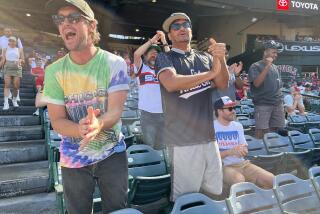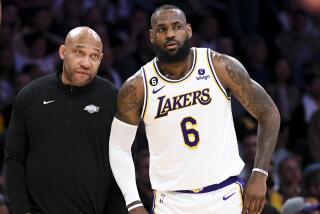THE HEX FILES
Mo Vaughn had no idea what he was stepping into April 6 when he plunged feet-first into the visitor’s dugout during the first inning of his first game as an Anaheim Angel.
Eighty million bucks might keep you toasty at night, but no truckload of cash covers first- and last-month’s rent on four decades of hoodoo.
For the record:
12:00 a.m. May 28, 1999 For the Record
Los Angeles Times Friday May 28, 1999 Home Edition Sports Part D Page 11 Sports Desk 1 inches; 23 words Type of Material: Correction
Sports Monthly--Ken Hubbs, the National League rookie of the year in 1962, was killed in a plane crash in 1964. The information was incorrect in a graphic Thursday.
Vaughn dismissed the opening-day misstep as a freak accident, this as Angel followers dating to ground (out) zero in 1961 reached for their witch oil.
We should be thankful Vaughn didn’t vaporize into thin air, given the Bermuda Triangle eeriness of this dis-harmonic convergence: Vaughn leaves the Boston Red Sox (Curse of the Bambino), signs with the Angels (Curse of the 57 Freeway?), wrenches his ankle chasing a popup into a dugout inhabited by the Cleveland Indians (Curse of Rocky Colavito).
“I don’t want to hear about jinxes and curses,” Vaughn huffed a few weeks later when asked about his death-defying debut.
Brave soldier, Mo.
Angel newcomers, so full of hope, typically start off like this: Gene Mauch’s bravado before Milwaukee in 1982; Bobby Valentine, boy wonder, the second before his cleats stuck in the center-field fence; Buzzie Bavasi, the Angels’ pragmatic former general manager, before Lyman Bostock’s 1978 murder.
We’re guessing that Angel bus driver in 1992 told the boys to “take a load off” before he turned wheels toward the New Jersey Turnpike.
You have to laud Vaughn’s optimism.
“Jinxes and curses are good for the media and fans,” he said, “but, as players, we can’t get caught up in that.”
Meanwhile, back at Voodoo Ranch, men with educations and reputations, men who should know better, had the same thought when Mo Money came tumbling down:
The Curse!
“Did we look at each other without saying a word?” said Tim Mead, Angel vice president of communications. “You better believe it.”
Bavasi, 84, took the news at home in La Jolla.
“I thought about it immediately,” Bavasi added. “I said, ‘Here we go again.’ ”
Ross Newhan, The Times’ national baseball writer, who has chronicled the Angels since 1961, called rewrite.
“You give Mo Vaughn $80 million, and his first game he falls down the dugout steps?” he asked.
Chuck Finley, pretty much numb to Angel misfortune after 14 years under the spell, almost expected it.
“You look at the Rams occupying this field also,” the pitcher said. “Maybe they were the smart ones by leaving.”
Change owners, team names, remodel the stadium, paint the seats green, whip up a waterfall in center field--put new potted plants in the lobby if it suits you. With the Angels, it’s always rearranging deck chairs on the you-know-what.
This spring, star shortstop Gary DiSarcina walked out of the batting cage and into the swing of coach George Hendrick. Tough break . . . of DiSarcina’s arm. Days after Vaughn’s ankle sprain, Gold Glove center fielder Jim Edmonds was lost (forever?) to shoulder surgery, soon to be joined on the disabled list by Tim Salmon because of a torn ligament in his left wrist.
Another series of random acts, or more tales from the crypt?
Babes, Chickens and Goats
Hexes and jinxes have long held court in the nether world.
Once, the spoken curse was thought so powerful a person would duck in hopes the evil words might pass overhead.
Professionals with degrees tell us curses in sports help explain the unexplainable, cover up front-office ineptitude, affix blame for failure.
“Just as Freud indicated that God is the projection of beliefs and desires of human beings, so too can belief in curses be understood as the projection of fears and feelings of inadequacy,” said Joseph Price, professor of religious studies at Whittier College.
Curses are illogical, a cop-out, a distraction, perhaps even sacrilegious.
Are they not?
“I haven’t bought into all that, the burial grounds, the curse,” Finley said. “The reason why other teams have won is because they were better. Every team probably has got their stories.”
Finley’s eyes gave him away, though.
Upon hearing a short recitation of tortured Angel history, Finley questioned whether it was all happenstance.
“The Donnie Moore incident, the bus crash,” Finley said. “Guys with their kids dying. Mark Leiter’s [son]. Rod [Carew’s] daughter. I’ve witnessed more than anyone else around. Most of the guys here think it’s normal. You’d like to think as athletes you can overcome it.”
Finley almost hired a witch doctor last year to “burn sage in the clubhouse.”
What stopped him?
“I didn’t want to scare anybody,” Finley said.
Some have seen too much.
“I understand it goes with the game,” he said of bad luck, “but I’d like someone to explain to me why it goes more with our game.”
The Angels are not the only “cursed” team in sports.
Theirs is not even the most infamous.
* The Boston Red Sox have been haunted by owner Harry Frazee’s foolish 1920 sale of Babe Ruth to the New York Yankees. The Red Sox won five championships between 1903 and 1918 but have appeared in only four World Series since, losing all in the seventh game.
You want spooky?
Boston has displayed the retired jersey numbers of four Red Sox players in Fenway Park: 9 (Ted Williams), 4 (Joe Cronin), 1 (Bobby Doerr) and 8 (Carl Yastrzemski).
9-4-18.
In month-date-year sequence, that’s Sept. 4, 1918, the eve of the last World Series in which the Red Sox prevailed. The next day, pitcher Babe Ruth shut out the Chicago Cubs, 1-0.
In his 1990 book, “The Curse of the Bambino,” Boston Globe writer Dan Shaughnessy chronicled Red Sox heartbreak since the Ruth giveaway.
“It is a story about baseball’s original sin--the selling of Babe Ruth--and the subsequent seventy years of sorrow for New England’s baseball fans,” Shaughnessy writes.
Whew, time flies. Make that 79 years of sorrow . . . and counting.
* The Chicago Cubs have not graced the World Series since 1945, the year tavern owner William “Billy Goat” Sianis cursed the team for Cub owner Phil Wrigley’s refusal to allow Sianis’ pet goat to occupy a seat during the Series against Detroit.
Cheeseburger, Cheeseburger, Pepsi, No Coke?
Ernie Banks, Sammy Sosa, Cubs lose. No joke.
John Belushi and Dan Aykroyd put the “Billy Goat Tavern” on the map with their 1970s “Saturday Night Live” parody, but Cub fans know the “Billy Goat” for another reason.
Sam Sianis, current tavern owner and William’s nephew, provides the 1945 World Series curse backdrop.
“Mr. Wrigley tells Billy to take his stinking goat out of here,” Sianis said by phone from his Chicago saloon. “Later, when the Cubs lost, Billy sends a telegram to Mr. Wrigley: ‘Who stinks now?’ ”
Sianis is often asked to lift the curse and sometimes obliges. In 1994, he trotted his goat around the Wrigley Field bases and the Cubs ended a 12-game losing streak.
However, Sianis said he and his goat were not invited west to the 1984 National League playoffs at San Diego--”Cubs lost”--and that his goat was rudely treated by a Wrigley Field guard during last year’s division series against Atlanta.
“Cubs lost.”
And pity the outsider who attempts to get the goat’s goat.
At Wrigley last year, Sianis said an Atlanta player made a disparaging remark about his bearded friend.
“He says, ‘That goat good for barbecue,’ ” Sianis recalled. “I said, ‘You guys going to get barbecued, because this goat is going to put a hex on you and [Greg] Maddux. They went to play Padres [for the pennant] and they lost.”
* The New Orleans Saints, located at Hex Headquarters, returned the franchise’s opening kickoff for a touchdown in 1967 but, 32 years hence, have yet to win a playoff game. We could not unearth an official curse on the Saints, but we weighed significantly where the team decided to set up shop.
* The Chicago White Sox have been a pox since the 1919 “Black Sox scandal,” when eight players were accused of conspiring to fix the World Series against Cincinnati. It’s also known as the “Curse of Joe Jackson,” some maintaining the White Sox have been perennially punished for the star player’s wrongful banishment from baseball and owner Charles Comiskey’s, um, sole-less betrayal of “Shoeless Joe.”
In a 1949 Sporting News interview, Jackson said he had no ax to grind, although he did offer, “I believe in the Good Book, particularly where it says, ‘What you sow, so shall you reap.’ ”
* Lou Holtz takes over as football coach at the University of South Carolina, bedeviled for a century by the dreaded “Chicken Curse.”
The hex was reportedly cast in the 1880s by U.S. Sen. “Pitchfork” Ben Tillman, founder of rival Clemson, so disgusted by the “bourbon” class that controlled the school he put the whammy on the Gamecocks.
The curse has been blamed for a barnyard full of athletic shortcomings, none more ghastly than South Carolina’s 1984 loss to Navy, a defeat that cost the Gamecocks a No. 1 ranking and possible national title.
“It’s beyond incompetence,” Frank Eppes, a South Carolina law school graduate, said of the school’s athletic struggles.
Eppes doesn’t like Holtz’s chances against the Chicken.
“Old Lou, he’s either going to save us or it’s going to kill Lou,” he said. “I’ll bet on No. 2.”
* Sports Illustrated. Some athletes contend an appearance on the magazine’s cover will lead to a downfall. Most literal example: Ted Williams tripped over his dog and broke his leg not long after gracing the Nov. 25, 1997 cover.
* The sophomore jinx. Exhibit A: Walt Dropo. Exhibit B: “Super Joe” Charboneau.
* The Masters hex over Greg Norman: Norman’s noggin has been spinning like Linda Blair’s since Larry Mize’s chip shot beat him in 1987.
* Kentucky Derby. The bettor’s curse? No favorite has won the race since Spectacular Bid in 1979.
What about jinxed players? Poor Bill Buckner played for the Red Sox, Cubs and the Angels.
Pleas to priests, witch doctors and shamans to rid teams of spells have largely been exorcises in futility.
On Sept. 4, 1992, Archibald Thibeaux, a retired witch doctor, took a whack at the “Chicken Curse.” In the South Carolina football stadium parking lot, he stirred gooey black liquid into a black caldron, dropped chicken bones and feathers into a pot, and chanted “Chicken Curse be gone! Go back up to Clemson.”
No such luck.
In fact, it scared Flynn Bowie, the Gamecock graduate who found Thibeaux, out of the witch doctor business.
The day Bowie posted the press release announcing Thibeaux’s upcoming appearance, he says his car was crushed while he and some friends were parked at a local fast-food restaurant.
The vehicle that struck him?
A chicken truck.
“My friend said, ‘You should have never messed with that curse,’ ” Bowie said.
Some franchises have 86ed the hex. The New York Rangers won the 1994 Stanley Cup after a 54-year drought blamed on the “Curse of the Cup,” so named after a Ranger executive, celebrating the team’s 1940 win, supposedly did dishonor to the chalice by burning the mortgage slip for Madison Square Garden in the cup.
The “Curse of the Leprechaun” at Boston Garden long tormented the Lakers--dead spots in the parquet floor, James Worthy’s pass to Gerald Henderson in 1984!-- until Magic and Co. cold-cocked the little bugger in 1985.
Cleveland’s lame-brained trade of its home run slugger in 1960 spawned the “Curse of Rocky Colavito,” sort of a Lake Erie knock-off of Boston’s Bambino boner.
The lake would catch fire before the Indians returned to the World Series in 1995.
Halos Take the Stake
Of all the jinxes in play, though, none hold a witch’s stick to the Angels’.
The curse lacks only an explanation and a catchy nickname.
“Curse of the Cowboy” is the obvious alliteration, although some think it is unfair to former owner Gene Autry.
“The thing that’s mysterious is that the nicest man the good Lord put on earth was Gene Autry,” Bavasi said. “He deserved a better fate.”
Those convinced the Angels are doomed because Anaheim Stadium may have been built on Indian burial ground--more on this later from the tribal chief--”Curse of the Cowboy” makes sense, given the general disdain American Indians had for Cowboys . . . even singing ones.
“It has to be more than coincidence,” Bavasi said of the Angel hex. “Someone in the organization the last 35 years did something the man upstairs didn’t like.”
Bavasi dismissed talk of the curse when he joined the front office in 1977.
Then, in a wrong-place, wrong-time 1978 tragedy, Angel outfielder Bostock, in his first year with the club after signing as a free agent, was shot to death while riding in a car with family and friends in Gary, Ind.
The murder rocked the organization.
Bavasi and fellow Angel executive Red Patterson decided to take action, asking Patterson’s monsignor to come out and bless Anaheim Stadium.
“Red and I felt there must have been something, you use the word jinx, on the club,” Bavasi said. “I didn’t believe anything until Lyman Bostock.”
Newhan, who has reported on the Angels for all of their 38 seasons, chronicled this trail of tears in his 1982 book, “The California Angels, the Complete History.”
Little did he know some of the worst was yet to come. Newhan is updating his book, due out this spring. He keeps an up-to-the-calamity Angel misery index, DiSarcina, Vaughn, Edmonds and, now, Salmon, the latest entries.
Curse or coincidence?
Judge for yourself:
1961: Johnny James, a promising pitching prospect, breaks a bone in his right arm while throwing a curve and never pitches again.
1962: Outfielder Ken Hunt, who hit 25 homers in 1961, cracks his collarbone while flexing a bat behind his back in the on-deck circle and never plays another full season.
1962: With the Angels, astoundingly, in a pennant race, relief pitcher Art Fowler loses sight in his left eye after being struck by a batting-practice line drive.
1964: Pitcher Ken McBride, an early ace, suffers neck and back injuries in a car accident and wins four more games in his career.
1964: Outfielder Rick Reichardt, an Angel bonus baby, has a kidney removed after being diagnosed with a blood disorder and never fulfills potential.
1965: Rookie pitcher Dick Wantz dies at age 25 of a brain tumor.
1968: First baseman Don Mincher and third baseman Paul Schaal are seriously beaned by pitches and never regain form. Minnie Rojas, a brilliant relief pitcher, is paralyzed in a car accident in which his wife and two of three children are killed.
1972: Utility infielder Chico Ruiz, 33, dies in an auto accident.
1973: Valentine, a star-on-the-rise shortstop subbing in center field one night, grotesquely fractures his leg when his spikes catch in the outfield fence. He never plays regularly again.
1974: Rookie reliever Bruce Heinbechner, 23, dies in a car accident.
1977: Shortstop Mike Miley, 23, is killed in a car crash; high-priced free agents Joe Rudi and Bobby Grich miss significant portions of the season. Grich herniates a disk in his back while lifting an air conditioner.
1978: Bostock is killed.
1979: Pitcher Jim Barr misses the playoffs after breaking his hand during a party celebrating the club’s first division title.
1982: Shortstop Rick Burleson, acquired in trade from Boston, tears his rotator cuff in spring training, effectively ending his career.
1986: First baseman Wally Joyner, hero of the Angels’ 1986 pennant chase, develops a staph infection in his leg and misses the final two games of the AL championship series against Boston. The Angels lose the pennant.
1989: Former reliever Donnie Moore, who gave up the infamous home run to Boston’s Dave Henderson in Game 5 of the 1986 AL playoffs--a game in which the Angels were within one pitch of reaching their first World Series--shoots his wife and then kills himself.
1992: Coach Deron Johnson dies of lung cancer. Pitcher Matt Keough requires emergency surgery after being hit in the head by a line drive.
Manager Buck Rodgers suffers serious injuries when the team bus careens off the New Jersey Turnpike.
1995: All-star shortstop Gary DiSarcina breaks his thumb on Aug. 3; the Angels blow an 11-game lead to Seattle, losing a one-game playoff to Seattle for the division title.
1997: Finley opens the season on the disabled because of a broken orbital bone after being struck by a flung bat during spring training and goes on disabled list again when he injures his wrist after slipping while backing up home plate.
Let’s make this clear: All organizations suffer injury and tragedy.
Many of the Angels’ on-field problems can be attributed to front-office bungling, bad trades--Tom Brunansky for Doug Corbett?--and lack of clear vision from first sunrise.
But it’s more than that with the Angels.
Curse watchers make the distinction between witchcraft and wretchedness.
The Clippers, for one, do not qualify for Cursehood.
The Clippers just stink.
The Angels have not done everything wrong.
In 1982, Bavasi molded a marvelous team, one that took a 2-0 lead against Milwaukee in a best-of-five series before, well, you know.
Game 5 of the 1986 AL playoffs, of course, remains encased under glass in the Museum of the Macabre.
Tim Mead, employed by the Angels since 1981, offers no excuses.
“No one wants to hear poor, woeful me,” Mead said.
The curse is not a subject he relishes discussing.
“It is not in our game notes,” Mead said. “We created ‘Little Ball’ with Mauch, but the curse is not a marketing slogan.”
Yet, the sinner’s scent in Anaheim wafts with the smell of popcorn and pine tar.
“If you’ve been around it, been a fan, part of the club, you see it,” Mead said. “You’ve seen things that are weird. We all come to work choosing to disregard public and media talk of the jinx, but do we privately wonder? Yeah, we shake our head and wonder.”
Newhan has seen enough to leave his skepticism at the stadium gate.
“I don’t believe in the supernatural,” Newhan said, “but there certainly has been a long history of numbing events the Angels have experienced.
“I have no answer. I don’t think it’s a journalistic misrepresentation to describe it after 38 years as something of a curse or hex, because each new major setback seems to add to the parade.”
Get a Life
Voodoo my eye.
Bob Singer, chair of the department of Exercise and Sports Sciences at the University of Florida, isn’t one for hocus-pocus theories.
The ball that Boston’s Buckner let skid under his glove in Game 6 of the 1986 World Series?
“I would say he just didn’t make the right play,” Singer said, “that he froze in the stress of the whole thing and just didn’t get down on the ball. Red Sox fans will say it was the curse. It depends on what you want to live with.”
Singer says followers of the Angels, Red Sox, Cubs, South Carolina, et al, may share a common bond.
“I think there is a certain segment of fans that really appreciate those that are doomed to be losers,” he said, “because we have a certain segment of society who feel that way about themselves, and maybe rightfully so.”
In “The Curse of the Bambino,” Shaughnessy offers a missive from Dr. Edward Hallowell that supports this theory.
“The real reason the Red Sox will never win the World Series is that Red Sox fans do not want them to,” Hallowell writes.
That said, Singer does believe the dark cloud that hovers over “jinxed” teams can affect morale and, thus, performance.
Singer has done extensive research on self-fulfilling prophecy.
He said in World War II, sugar-coated placebos given to wounded soldiers were found to be 70% to 80% as effective as real medicine.
“If enough is written and said about the bad-luck phenomenon, then there’s a tendency, deliberately or non-deliberately, to look for that to happen,” Singer said.
Call it good vs. bad vibes.
Rene Lachemann, coach for the haunted 1986 Red Sox, admitted in Shaughnessy’s book that Ruth’s curse is a 15-ton load.
“The skeletons here go back to grandmothers and grandfathers and everything else,” Lachemann said. “It’s mentally draining.”
Grounds for Removal?
On Aug. 31, 1964, smack-dab in a corn field, with Mickey Mouse presiding, construction began on Anaheim Stadium. The project was completed at a cost of $24 million and the Angels began play there in 1966.
Angel fans remember it as 19666.
There is no proof the stadium was built on Indian burial ground.
“But nobody can really say positively no,” Jane Newell, the city of Anaheim’s local history curator, admitted.
Newell ran a records check.
“As far as we can tell, looking in books and files, there is nothing to verify a village, let alone a burial ground,” Newell said.
The Indians are not as convinced.
The Juanenos have inhabited the area for 10,000 years. They lived and died in hamlets along the Santa Ana River bed that runs adjacent to what is now Edison International Field.
During a recent road grading project in the nearby El Toro Hills, a fire hearth dating back 8,500 years was unearthed 40 feet under ground.
The Juanenos, the colonized name for the Acjachemen, were enslaved by the Spanish in the 18th century. The Spanish were Catholics. The Catholics believe in . . . Angels.
David Belardes, 52, tribal chief for the estimated 3,000 to 4,000 Juanenos remaining in Orange County, cannot verify whether Anaheim Stadium was built on sacred ground because laws protecting Juaneno land from developers were not enacted until the 1970s.
“The possibility is there,” Belardes said. “A lot of that stuff was ‘hurry up and bulldoze the area before anybody knows.’ They could have hit something and kept it very quiet, because I never heard anything about it.”
Belardes says his tribe has not formally cursed the Angels, but adds that if the stadium was built on burial ground, it could explain a lot of things.
“I get calls all the time from people that have strange happenings,” he said. “Either the area they live, or in their homes, and I’m sent out to bless the area. A ceremony to help them out. Sometimes it does. Sometimes it doesn’t.
“There’s a lot of folklore in San Juan about ghosts and spirits. People don’t respect the people that were there before them. Most of the time they don’t have any knowledge, a lot of time they don’t ask permission to be in the space.”
Et tu, Halos?
Silver Linings
The good news for Angel fans is that amputation was not required for Vaughn’s ankle sprain.
“The main thing is that it wasn’t career-ending to me,” Vaughn said.
DiSarcina, Edmonds and Salmon may be back for this year’s stretch run.
The Angels aren’t out of the pennant race--yet.
“My injury was a fluke,” Vaughn said. “It happens.”
You want to believe.
“If you put the best baseball team on the field and work together as a unit--you take care of that--and the Anaheim Angels will win the World Series,” Vaughn said.
The experts agree.
“They’re jinxed as long as they believe they are,” said Joe Price, the religious scholar. “When they fully believe they’re no longer jinxed, they’ll break out of the hex.”
The Angels need a new battle cry: We’ve Got Next . . . Millennium.
“You will be amazed how little the curse is talked about after we get to the World Series,” Tim Mead said.
Until then, boys, watch your steps.
(BEGIN TEXT OF INFOBOX / INFOGRAPHIC)
STILL WAITING
TEAMS WITHOUT A WORLD SERIES CHAMPIONSHIP (30 YEARS OR MORE)
CHICAGO CUBS: 91 years (1908)
CHICAGO WHITE SOX: 82 years (1917)
BOSTON RED SOX: 81 years (1918)
CLEVELAND INDIANS: 51 years (1948)
NEW YORK/SAN FRANCISCO GIANTS: 45 years (1954)
ANGELS: 38 years (1961)
WASHINGTON SENATORS / TEXAS RANGERS: 38 years (1961)
HOUSTON ASTROS: 37 years (1962)
SEATTLE PILOTS / MILWAUKEE BREWERS: 30 years (1969)
MONTREAL EXPOS: 30 years (1969)
SAN DIEGO PADRES: 30 years (1969)
****
TEAMS WITHOUT A WORLD SERIES APPEARANCE (30 YEARS OR MORE)
CHICAGO CUBS: 54 years (1945)
CHICAGO WHITE SOX: 40 years (1959)
ANGELS: 38 years (1961)
WASHINGTON SENATORS / TEXAS RANGERS: 38 years (1961)
HOUSTON ASTROS: 37 years (1962)
MONTREAL EXPOS: 30 years (1969)
****
ROOKIE-OF-THE-YEAR JINX:
1962--Ken Hubbs: Chicago Cubs--Hit .260 and played strong defense at second. Killed in car accident before 1964 season began.
1976--Mark Fidrych: Detroit Tigers--After 19-9: 2.34 ERA season: Fidrych injured arm midway through 1977 season and pitched in only 16 more games.
1998--Kerry Wood: Chicago Cubs--After one of the best rookie seasons for a pitcher ever: Cub right-hander tore a ligament in elbow and is not expected return until midway through 2000 season.
****
THEY AIN’T GREAT
Fewest victories in NFL playoffs since AFL merger in 1970:
New Orleans: 0-4
Arizona: 1-4
Detroit: 1-8
Carolina: 1-1
Tampa Bay: 2-4
More to Read
Go beyond the scoreboard
Get the latest on L.A.'s teams in the daily Sports Report newsletter.
You may occasionally receive promotional content from the Los Angeles Times.







